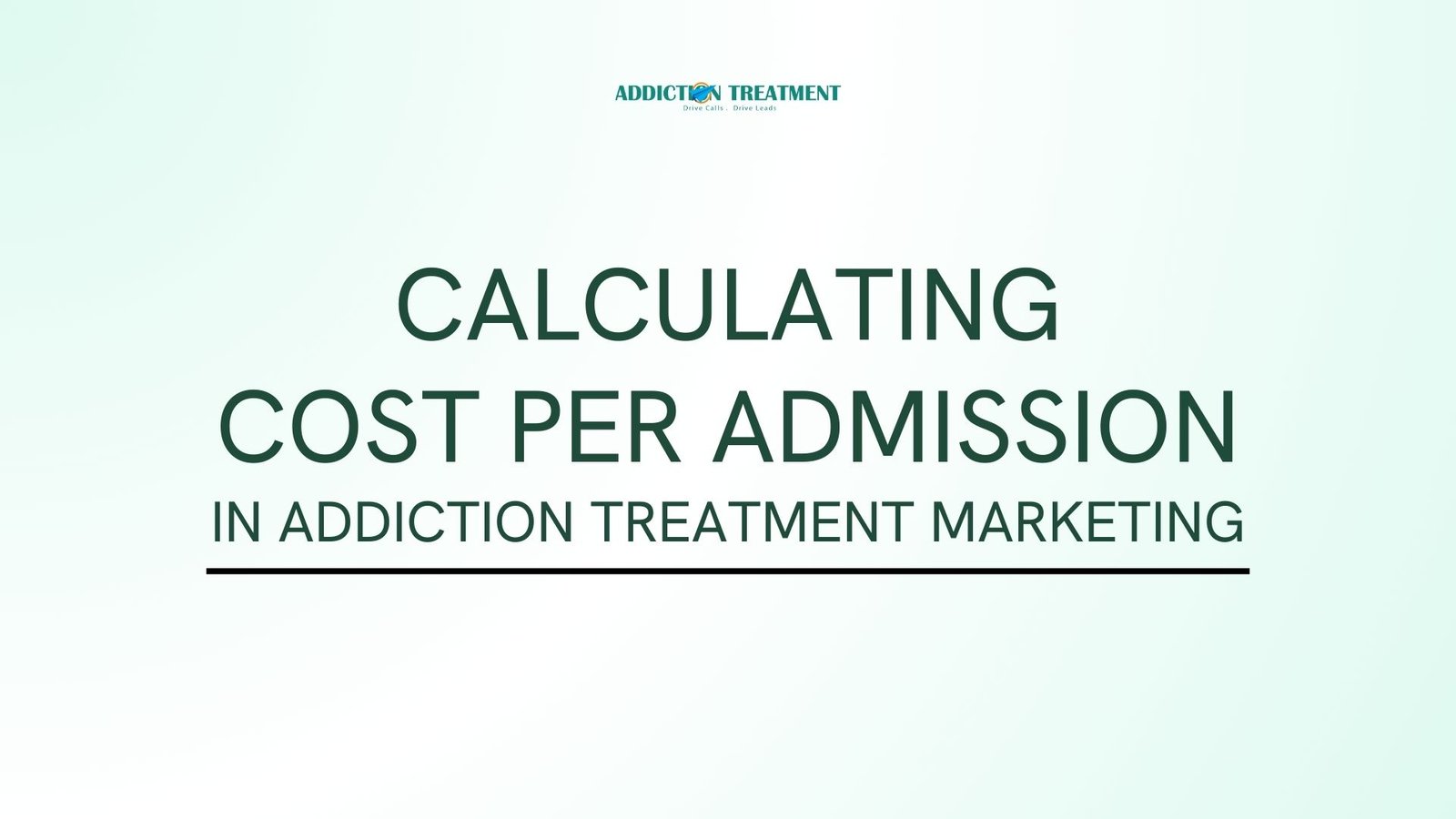In addiction treatment marketing, understanding and optimizing Cost Per Admission (CPA) is critical for ensuring the financial sustainability of your facility. CPA represents the cost incurred to acquire a new client who successfully enrolls in your program. This metric varies widely based on factors like accepted insurance types, the availability of cash payment options, and the marketing strategies employed.
In this article, we’ll dive into the true cost of admission, provide a step-by-step guide to calculating CPA, and offer actionable tips for optimizing it.
What is Cost Per Admission (CPA)?
Cost Per Admission (CPA) is a marketing metric that calculates the total cost required to bring a client into your addiction treatment center. It takes into account all marketing expenses and provides an accurate representation of your facility’s client acquisition efficiency.
Example Scenario:
If your treatment center spends $50,000 on marketing and acquires 10 clients in a month, your CPA would be $5,000. This value can vary significantly depending on the type of marketing campaigns, insurance coverage options, and payment flexibility.
Why CPA Varies in Addiction Treatment Marketing
The average CPA ranges from $5,000 to $10,000 for addiction treatment facilities, influenced by the following factors:
- Insurance Acceptance:
Centers that accept multiple types of insurance—In-Network and Out-of-Network—can lower their CPA significantly. For example, by accepting both insurance types, your facility may acquire admissions at an average cost of $5,000. This flexibility increases the pool of eligible clients, boosting conversions. - Cash Payment Options:
Facilities that accept cash payments may have a higher CPA due to a smaller target audience but can balance this with higher revenue per admission. - Marketing Channels:
Different channels like pay-per-call campaigns, PPC advertising, or organic SEO efforts have varying costs and conversion rates, directly impacting CPA. - Lead Quality:
High-quality leads, such as those generated through targeted campaigns or referral partnerships, tend to lower CPA by increasing the likelihood of conversion. - Competition:
In highly competitive markets, advertising costs and client acquisition challenges can drive CPA higher.
How to Calculate CPA
To calculate CPA, use the formula:
CPA=Total Marketing CostsNumber of Admissions\text{CPA} = \frac{\text{Total Marketing Costs}}{\text{Number of Admissions}}CPA=Number of AdmissionsTotal Marketing Costs
Steps to Calculate CPA:
- Determine Total Marketing Costs:
Include all expenses related to lead generation, such as:- Advertising (Google Ads, Facebook Ads, etc.).
- Pay-per-call campaigns.
- Salaries of marketing staff.
- Content creation and SEO investments.
- Software tools (CRM systems, call tracking platforms).
- Track Total Admissions:
Count the number of clients admitted as a result of your marketing efforts. - Divide Costs by Admissions:
Use the formula to calculate CPA.
Example Calculation:
- Total marketing costs: $75,000
- Total admissions: 15
- CPA = $75,000 ÷ 15 = $5,000 per admission
How CPA Relates to Revenue
Understanding CPA in the context of your center’s revenue per admission is critical for profitability.
- Average Revenue Per Admission:
Treatment programs typically generate $20,000 to $50,000 per client, depending on the duration of care and payment methods. - Target CPA:
To ensure profitability, aim for a CPA that is significantly lower than your average revenue per client. For example, if your revenue per client is $25,000, a CPA of $5,000 to $10,000 ensures healthy margins.
Optimizing CPA for Addiction Treatment Centers
- Focus on High-Intent Leads:
Targeting individuals actively seeking inpatient or outpatient care reduces wasted spend. Strategies include:- Pay-per-call campaigns.
- Local SEO for high-converting keywords like “rehab near me” or “inpatient addiction treatment.”
- Diversify Marketing Channels:
Use a mix of PPC ads, content marketing, and referral partnerships to balance acquisition costs and maximize reach. - Improve Insurance Verification Processes:
Streamlining insurance checks during the lead qualification process ensures you focus on clients likely to convert. - Leverage Analytics:
Use tools like Google Analytics and CRM software to track campaign performance and identify high-performing channels. - Optimize Conversion Rates:
Enhance website UX, simplify forms, and train your intake team to handle inquiries effectively. - Refine Targeting in PPC Campaigns:
Narrow targeting to focus on geographic locations, demographics, and high-performing keywords to reduce ad spend wastage.
Comparing CPA Across Marketing Channels
Here’s how CPA typically compares across popular marketing channels:
- Pay-Per-Call Campaigns:
- Average CPA: $5,000-$8,000
- Why It Works: High-intent leads calling directly are more likely to convert, justifying the investment.
- Google Ads:
- Average CPA: $5,000-$10,000 depending on competition.
- Key to Success: Compliance with LegitScript certification ensures your ads reach qualified clients.
- Social Media Ads:
- Average CPA: $6,000-$9,000
- Best Use: Targeting families of individuals seeking treatment or running awareness campaigns.
- SEO:
- Average CPA: $4,000-$6,000 (after initial investment).
- Why It’s Effective: Long-term visibility reduces reliance on paid campaigns, lowering CPA over time.
- Referral Partnerships:
- Average CPA: $4,000-$7,000
- Value: Trusted referrals from healthcare professionals lead to higher conversion rates.
Challenges in Maintaining a Low CPA
- Seasonal Demand Variations:
CPA may increase during off-peak seasons when fewer individuals seek treatment. - High Competition:
In competitive regions, advertising costs for high-converting keywords may drive up CPA. - Lead Volume Management:
Handling too many leads without proper qualification can inflate CPA through inefficiencies. - Regulatory Compliance:
Meeting advertising requirements, such as LegitScript and HIPAA compliance, adds complexity and cost to campaigns.
Conclusion
Calculating and optimizing Cost Per Admission (CPA) is a vital part of addiction treatment marketing. By accepting both In-Network and Out-of-Network insurance, you can potentially reduce your CPA to as low as $5,000, making your facility accessible to a wider audience while maintaining profitability.
With strategies like focusing on high-intent leads, leveraging diverse marketing channels, and refining campaign performance, treatment centers can balance costs and admissions effectively. Understanding CPA and the factors influencing it ensures that your marketing efforts create meaningful connections with those seeking help, driving both impact and success.


Leave a Reply